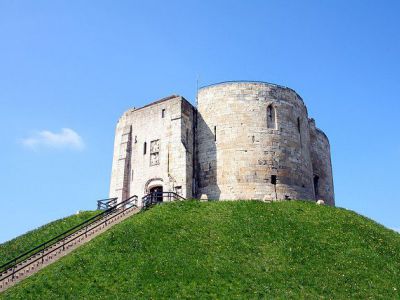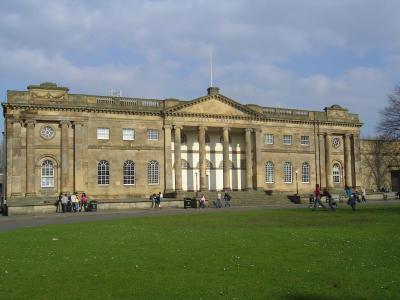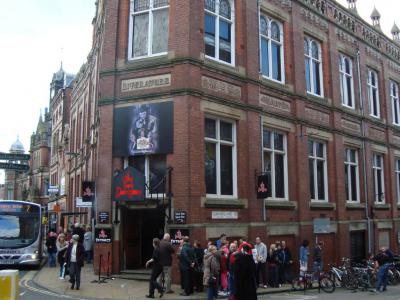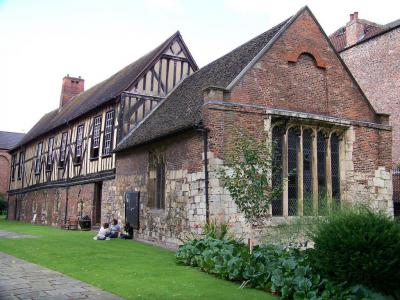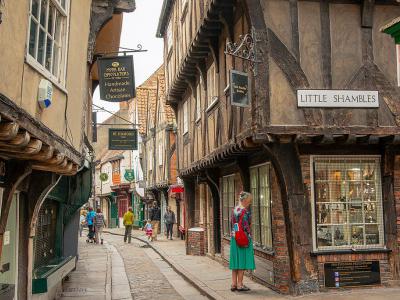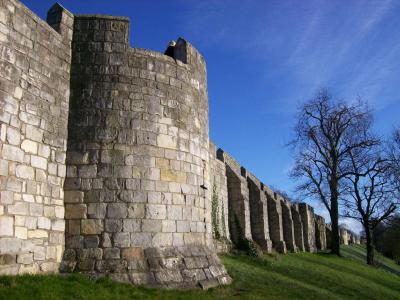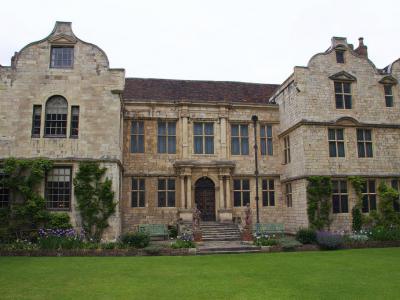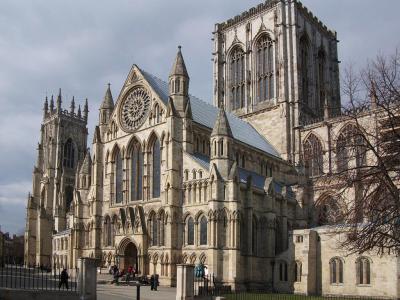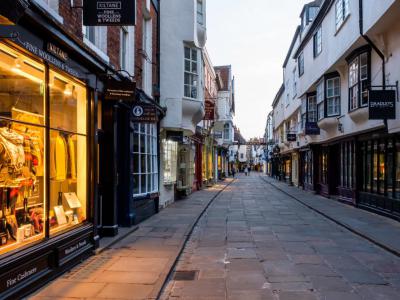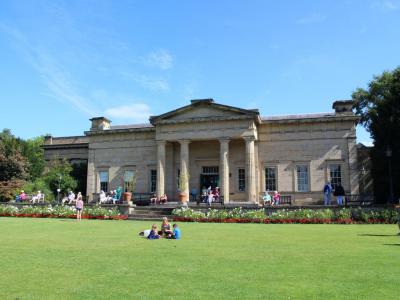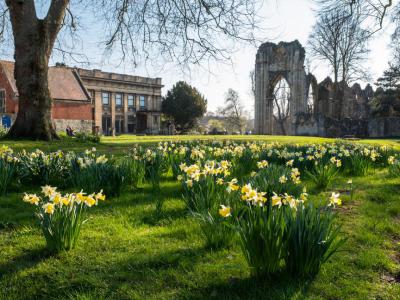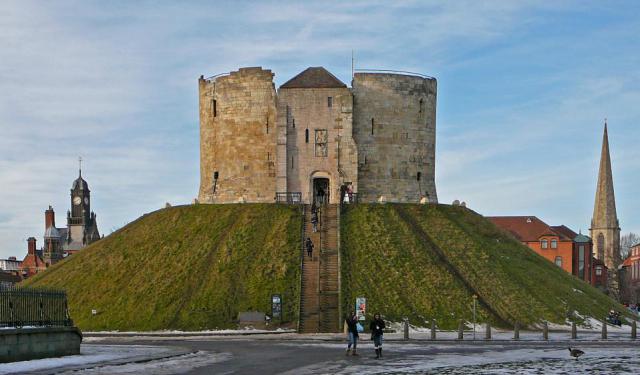York Introduction Walking Tour (Self Guided), York
Established by the ancient Romans in 71 AD, the city of York breathes history. It first appeared as a walled settlement when the Ninth Legion of Rome conquered the local tribe known as the Brigantes. The town became the capital of the Roman province of Britannia Inferior, and later of the kingdoms of Deira, Northumbria and Jórvík, emerging as a major river port and part of the extensive trading routes throughout northern Europe.
The word York is derived from the Brittonic name Eburākon, which is a combination of eburos "yew-tree" and a suffix -āko[n] meaning "belonging to-, place of-". When the Danish army, led by Ivar the Boneless and Halfdan, conquered the city in 866, its name became Jórvík, which gradually reduced to York in the centuries following the Norman invasion by William the Conqueror in the 1060s.
In the Middle Ages, York grew as a major wool trading center and became the capital of the northern ecclesiastical province of the Church of England, a role it has retained. In the 19th century, the city became a major hub of the railway network and a confectionery manufacturing center, a status it maintained well into the 20th century. During the Second World War, York was bombed as part of the Baedeker Blitz. Although less affected by bombing than other northern cities, several historic buildings were gutted and restoration efforts continued into the 1960s.
With the emergence of tourism, the historic core of York became one of the city's major assets, and in 1968 it was designated a conservation area. Among other attractions, the latter includes the huge (second-largest in northern Europe) 13th-century Gothic cathedral – York Minster – with medieval stained glass and two functioning bell towers; the City Walls on both sides of the River Ouse with four main gates, known as "bars", housing an exhibition tracing the life of 15th-century Plantagenet King Richard III; the Stonegate street, described as the most attractive in the city and one of its busiest; and more.
The above were supplemented by the establishment of the Jorvik Viking Centre in 1984, revealing a Viking settlement with numerous 1,000-year-old artifacts; and the York Dungeon in 1986, featuring a live-action horror show based on factual events from the city's history.
If you wish to learn more about York's turbulent past and discover the way it is today, follow this introductory walk and explore York in its variety.
The word York is derived from the Brittonic name Eburākon, which is a combination of eburos "yew-tree" and a suffix -āko[n] meaning "belonging to-, place of-". When the Danish army, led by Ivar the Boneless and Halfdan, conquered the city in 866, its name became Jórvík, which gradually reduced to York in the centuries following the Norman invasion by William the Conqueror in the 1060s.
In the Middle Ages, York grew as a major wool trading center and became the capital of the northern ecclesiastical province of the Church of England, a role it has retained. In the 19th century, the city became a major hub of the railway network and a confectionery manufacturing center, a status it maintained well into the 20th century. During the Second World War, York was bombed as part of the Baedeker Blitz. Although less affected by bombing than other northern cities, several historic buildings were gutted and restoration efforts continued into the 1960s.
With the emergence of tourism, the historic core of York became one of the city's major assets, and in 1968 it was designated a conservation area. Among other attractions, the latter includes the huge (second-largest in northern Europe) 13th-century Gothic cathedral – York Minster – with medieval stained glass and two functioning bell towers; the City Walls on both sides of the River Ouse with four main gates, known as "bars", housing an exhibition tracing the life of 15th-century Plantagenet King Richard III; the Stonegate street, described as the most attractive in the city and one of its busiest; and more.
The above were supplemented by the establishment of the Jorvik Viking Centre in 1984, revealing a Viking settlement with numerous 1,000-year-old artifacts; and the York Dungeon in 1986, featuring a live-action horror show based on factual events from the city's history.
If you wish to learn more about York's turbulent past and discover the way it is today, follow this introductory walk and explore York in its variety.
How it works: Download the app "GPSmyCity: Walks in 1K+ Cities" from Apple App Store or Google Play Store to your mobile phone or tablet. The app turns your mobile device into a personal tour guide and its built-in GPS navigation functions guide you from one tour stop to next. The app works offline, so no data plan is needed when traveling abroad.
York Introduction Walking Tour Map
Guide Name: York Introduction Walking Tour
Guide Location: England » York (See other walking tours in York)
Guide Type: Self-guided Walking Tour (Sightseeing)
# of Attractions: 12
Tour Duration: 2 Hour(s)
Travel Distance: 2.6 Km or 1.6 Miles
Author: val
Sight(s) Featured in This Guide:
Guide Location: England » York (See other walking tours in York)
Guide Type: Self-guided Walking Tour (Sightseeing)
# of Attractions: 12
Tour Duration: 2 Hour(s)
Travel Distance: 2.6 Km or 1.6 Miles
Author: val
Sight(s) Featured in This Guide:
- Clifford's Tower
- York Castle Museum
- York Dungeon
- JORVIK Viking Centre
- Merchant Adventurers' Hall
- The Shambles
- York City Walls
- Treasurer's House
- York Minster
- Stonegate
- Yorkshire Museum
- Yorkshire Museum Gardens
1) Clifford's Tower (must see)
Clifford's Tower in York is a historical site steeped in a rich and tumultuous past. It stands as the largest surviving part of York Castle, which was once northern England's most formidable medieval royal fortress. The tower has recently been enhanced with a significant update in 2022, which includes a dramatic roof deck, internal walkways, and a soundscape interpretation that narrates the tower's compelling history like never before. These new features make its history and interior more accessible, providing a vivid account of its dramatic and sometimes tragic events.
Originally constructed by William the Conqueror in 1068-69, Clifford's Tower was built to assert control over the rebellious north. The tower has endured multiple devastations, having been burned down twice before being reconstructed by Henry III in the 13th century. It is named after a particularly dark event where Roger de Clifford was executed for treason against Edward II and displayed on the tower walls.
Today, the tower's stone structure, dating from the late 13th century, invites visitors to explore its multifaceted history. The site is not only significant for its military and royal associations but also as a tragic site of the 1190 massacre of about 150 Jews who sought refuge there. Visitors can climb to the top of the tower to walk the open-air wall that guards once patrolled, offering unparalleled views of York, including the Old Minister, the North York Moors, and other remnants of York Castle.
From this vantage point, one can also view the "Eye of York"-a collection of buildings that includes the Female Prison, Debtor's Prison, and the Assize Courts, enhancing the understanding of York's historical and architectural development. The panoramic views from the tower make it an ideal starting point for anyone visiting the city.
The ground floor of Clifford's Tower, once the royal exchequer, now invites visitors to explore its history. A tactile model in the courtyard showcases its unique, possibly French-inspired four-lobed architecture. The first floor features a richly decorated chapel, formerly private apartments. Historically, the tower has served as a prison and royal mint, and it was here that the infamous highwayman Dick Turpin was identified, leading to his execution in 1739.
Originally constructed by William the Conqueror in 1068-69, Clifford's Tower was built to assert control over the rebellious north. The tower has endured multiple devastations, having been burned down twice before being reconstructed by Henry III in the 13th century. It is named after a particularly dark event where Roger de Clifford was executed for treason against Edward II and displayed on the tower walls.
Today, the tower's stone structure, dating from the late 13th century, invites visitors to explore its multifaceted history. The site is not only significant for its military and royal associations but also as a tragic site of the 1190 massacre of about 150 Jews who sought refuge there. Visitors can climb to the top of the tower to walk the open-air wall that guards once patrolled, offering unparalleled views of York, including the Old Minister, the North York Moors, and other remnants of York Castle.
From this vantage point, one can also view the "Eye of York"-a collection of buildings that includes the Female Prison, Debtor's Prison, and the Assize Courts, enhancing the understanding of York's historical and architectural development. The panoramic views from the tower make it an ideal starting point for anyone visiting the city.
The ground floor of Clifford's Tower, once the royal exchequer, now invites visitors to explore its history. A tactile model in the courtyard showcases its unique, possibly French-inspired four-lobed architecture. The first floor features a richly decorated chapel, formerly private apartments. Historically, the tower has served as a prison and royal mint, and it was here that the infamous highwayman Dick Turpin was identified, leading to his execution in 1739.
2) York Castle Museum (must see)
York Castle Museum was built on the site of York Castle. York Castle was originally built by William the Conqueror in 1068. However, York Castle fell into ruins, and two prisons were built using stone from the ruined castle.
The York Castle Museum is located in the two former prisons, which are now connected by a gallery. The Debtor's Prison is a three-story building completed in 1705. The Female Prison was completed in 1783. Dick Turpin, an infamous highwayman, was captured and imprisoned in The Debtor's Prison.
The Raindale Mill was moved to the museum grounds in the 1960s. This reconstructed 19th-century flour mill was used to grind grain into flour.
The museum was founded in 1938 by John L. Kirk. Kirk had a large collection of Social History items he wished to display, and the City of York decided to collaborate with him. Kirk recreated a Victorian street to display his various Victorian items. The Toy Stories exhibition focuses on the history of children's toys. The Sixties exhibition tells the stories of that radical decade. The Cells tells stories of life in The Debtor's Prison and The Female Prison. 1914: When the World Changed Forever commemorates World War I. Finally, Shaping the Body: Food, Fashion & Life focuses on the fashion industry.
Why You Should Visit:
The York Castle invites visitors to step back in time and immerse themselves in Victorian History. Instead of seeing objects in glass cases, visitors can see historic items set amongst a shopping street.
Tip:
Try to time your visit with the half-hour guided tour through Kirkgate (very interesting and informative) and take some 20p coins to have a go on the machines from the old days.
The York Castle Museum is located in the two former prisons, which are now connected by a gallery. The Debtor's Prison is a three-story building completed in 1705. The Female Prison was completed in 1783. Dick Turpin, an infamous highwayman, was captured and imprisoned in The Debtor's Prison.
The Raindale Mill was moved to the museum grounds in the 1960s. This reconstructed 19th-century flour mill was used to grind grain into flour.
The museum was founded in 1938 by John L. Kirk. Kirk had a large collection of Social History items he wished to display, and the City of York decided to collaborate with him. Kirk recreated a Victorian street to display his various Victorian items. The Toy Stories exhibition focuses on the history of children's toys. The Sixties exhibition tells the stories of that radical decade. The Cells tells stories of life in The Debtor's Prison and The Female Prison. 1914: When the World Changed Forever commemorates World War I. Finally, Shaping the Body: Food, Fashion & Life focuses on the fashion industry.
Why You Should Visit:
The York Castle invites visitors to step back in time and immerse themselves in Victorian History. Instead of seeing objects in glass cases, visitors can see historic items set amongst a shopping street.
Tip:
Try to time your visit with the half-hour guided tour through Kirkgate (very interesting and informative) and take some 20p coins to have a go on the machines from the old days.
3) York Dungeon (must see)
York Dungeon, located in York, offers a unique blend of education and entertainment through its portrayal of the darker aspects of local history. This attraction, which opened its doors in 1986, was the second such Dungeon, following the London Dungeon established in 1974. Both attractions are designed as interactive live-action horror shows, drawing from historical events but presented with a theatrical twist.
At the York Dungeon, visitors experience history through actor-led shows, complete with special effects and detailed models and displays. The tours at the Dungeon are particularly structured, beginning every 7 minutes and lasting anywhere from one to one and a half hours. These tours guide visitors through a series of dramatically reconstructed scenes and historical reenactments.
One of the standout experiences at the York Dungeon is the Great Plague show. Set in 1551, this exhibit recreates a plague doctor’s surgery, where an actor, playing the role of an assistant to a deceased plague doctor, leads the narration. Another significant highlight is the recreation of The Golden Fleece Inn, a historic York pub, where visitors gather to hear chilling local ghost stories.
Additional shows enrich the Dungeon experience. These include the "Judgement of Sinners," where visitors find themselves accused of various historical crimes, and the "Torture Chamber," which showcases gruesome torture devices. Throughout the tour, actors in the roles of plague doctors’ assistants, innkeepers, night watches, torturers, judges, executioners, stagecoach guards, and witch-burners engage with the audience, sharing macabre and thrilling tales.
York Dungeon thus serves as a portal to the past, inviting visitors to explore the grim and eerie aspects of York’s history in a uniquely immersive environment.
Why You Should Visit:
Atmospheric and realistic. The actors are very good and the stories are entertaining. Some surprises and audience participation were used well.
At the very least, you get an insight into some of the poor living and health conditions that folks had to put up with along with the barbarity of those in power.
Tip:
Pre-book online so you can turn up at your time and just go straight in; otherwise, risk being turned away or waiting in a lengthy queue.
At the York Dungeon, visitors experience history through actor-led shows, complete with special effects and detailed models and displays. The tours at the Dungeon are particularly structured, beginning every 7 minutes and lasting anywhere from one to one and a half hours. These tours guide visitors through a series of dramatically reconstructed scenes and historical reenactments.
One of the standout experiences at the York Dungeon is the Great Plague show. Set in 1551, this exhibit recreates a plague doctor’s surgery, where an actor, playing the role of an assistant to a deceased plague doctor, leads the narration. Another significant highlight is the recreation of The Golden Fleece Inn, a historic York pub, where visitors gather to hear chilling local ghost stories.
Additional shows enrich the Dungeon experience. These include the "Judgement of Sinners," where visitors find themselves accused of various historical crimes, and the "Torture Chamber," which showcases gruesome torture devices. Throughout the tour, actors in the roles of plague doctors’ assistants, innkeepers, night watches, torturers, judges, executioners, stagecoach guards, and witch-burners engage with the audience, sharing macabre and thrilling tales.
York Dungeon thus serves as a portal to the past, inviting visitors to explore the grim and eerie aspects of York’s history in a uniquely immersive environment.
Why You Should Visit:
Atmospheric and realistic. The actors are very good and the stories are entertaining. Some surprises and audience participation were used well.
At the very least, you get an insight into some of the poor living and health conditions that folks had to put up with along with the barbarity of those in power.
Tip:
Pre-book online so you can turn up at your time and just go straight in; otherwise, risk being turned away or waiting in a lengthy queue.
4) JORVIK Viking Centre (must see)
The Vikings captured York in 866 AD and settled the area until William the Conqueror invaded in 1066. In 1972, an excavation revealed evidence of the Viking settlement. The dig showed up to nine meters (29 feet) of layers. The layers protected delicate historical items such as clothing, timber, leather shoes, seeds, and insects. The dig continued, and over the next five years, archeologists found over 40,000 items.
The dig found Roman and medieval roof tiles re-used by Vikings, the timber used for buildings, metal slag, and pottery. The discoveries enabled scientists to envision how the Vikings lived, the layouts of buildings, what the Jorvik people ate, and how they spent their time.
To show visitors what life in Jorvik was like, the center has created an immersive experience. Visitors travel through the re-created Viking city in a time capsule ride. As visitors travel 1,000 years in the past, they will meet different animatronic Vikings, traders, Anglo-Saxons, and settlers from Ireland.
Visitors can then leave the ride and see 1,000-year-old artifacts up close. For example, visitors can admire ancient earrings, padlocks, and socks.
Tip:
It is worth booking in advance – for a little extra you jump the queue. Tickets are also valid for a year's worth of visits.
Once inside, ask the staff about what to look out for and they will point out some interesting things about the place you would never have realized.
The dig found Roman and medieval roof tiles re-used by Vikings, the timber used for buildings, metal slag, and pottery. The discoveries enabled scientists to envision how the Vikings lived, the layouts of buildings, what the Jorvik people ate, and how they spent their time.
To show visitors what life in Jorvik was like, the center has created an immersive experience. Visitors travel through the re-created Viking city in a time capsule ride. As visitors travel 1,000 years in the past, they will meet different animatronic Vikings, traders, Anglo-Saxons, and settlers from Ireland.
Visitors can then leave the ride and see 1,000-year-old artifacts up close. For example, visitors can admire ancient earrings, padlocks, and socks.
Tip:
It is worth booking in advance – for a little extra you jump the queue. Tickets are also valid for a year's worth of visits.
Once inside, ask the staff about what to look out for and they will point out some interesting things about the place you would never have realized.
5) Merchant Adventurers' Hall
This guildhall in the city of York was one of the most important buildings in the medieval city. The majority of the Hall was built in 1357 by a group of influential men and women who came together to form a religious fraternity called the Guild of Our Lord Jesus and the Blessed Virgin Mary. The main part of the building consists of the Great Hall, the Undercroft and the Chapel.
The Great Hall is where is where the medieval merchants first gathered to conduct their business and to socialize. It is the largest timber-framed building in the UK still standing and used for its original purpose. The roof of the hall is of two spans supported by a row of large central timber posts. It includes complex crown posts and is held together by wooden pegs.
The Undercroft was was originally a hospital or almshouse for poor people of York. Like the Great Hall, the Undercroft is divided in two by its supporting row of timber posts. The undercroft also provides access to an attached chapel.
The Chapel was build for the spiritual use of the ill and poor in the hospital as well as the members of the the Merchant Adventurers' Guild. It is still used for worship today.
Merchant Adventurers' Hall is one of the best preserved medieval guildhalls in the world and is well worth being included on your York itinerary.
The Great Hall is where is where the medieval merchants first gathered to conduct their business and to socialize. It is the largest timber-framed building in the UK still standing and used for its original purpose. The roof of the hall is of two spans supported by a row of large central timber posts. It includes complex crown posts and is held together by wooden pegs.
The Undercroft was was originally a hospital or almshouse for poor people of York. Like the Great Hall, the Undercroft is divided in two by its supporting row of timber posts. The undercroft also provides access to an attached chapel.
The Chapel was build for the spiritual use of the ill and poor in the hospital as well as the members of the the Merchant Adventurers' Guild. It is still used for worship today.
Merchant Adventurers' Hall is one of the best preserved medieval guildhalls in the world and is well worth being included on your York itinerary.
6) The Shambles (must see)
The Shambles is a historic street. Shambles refers to a meat market, and several streets with butcher shops are named The Shambles. Butcher stalls in this area were named in the 1086 Doomsday Book. The oldest buildings that line The Shambles today were built in the 14th century, and most were built by 1475. By 1426 the street was known as the Great Flesh Shambles, and later the street name was shortened to The Shambles.
Slaughterhouses were set up at the back of the butcher shops. The pavements were raised on the cobblestone street to allow easier cleaning of blood.
This narrow street features overhanging buildings, and some areas are so skinny that visitors can touch both sides of the street at once. The overhanging buildings would have sheltered the walls below and protected the display meat from the sun.
Visitors will find a shrine to Saint Margaret Clitherow on this street. Known as the "Pearl of York," she was martyred in 1586 for refusing to enter a plea to the charge of harboring Catholic priests. Saint Margaret Clitherow was married to a butcher and lived on The Shambles.
Butchers no longer line The Shambles, but several buildings still display meat hooks and meat shelves on display. Today's shops include restaurants, a bakery, and a bookshop.
Shambles Market runs daily between The Shambles and Parliament Street.
Why You Should Visit:
The Shambles is known as one of the best-preserved medieval streets in England. While fans believe it may have been the inspiration for Harry Potter's Diagon Alley, author J.K Rowling has denied these rumors. Regardless, the charming narrow street will transport visitors back in time.
Tips:
Visitors will also love exploring the five snickelways that lead off The Shambles. These snickelways are narrow alleys that connect to other streets.
Slaughterhouses were set up at the back of the butcher shops. The pavements were raised on the cobblestone street to allow easier cleaning of blood.
This narrow street features overhanging buildings, and some areas are so skinny that visitors can touch both sides of the street at once. The overhanging buildings would have sheltered the walls below and protected the display meat from the sun.
Visitors will find a shrine to Saint Margaret Clitherow on this street. Known as the "Pearl of York," she was martyred in 1586 for refusing to enter a plea to the charge of harboring Catholic priests. Saint Margaret Clitherow was married to a butcher and lived on The Shambles.
Butchers no longer line The Shambles, but several buildings still display meat hooks and meat shelves on display. Today's shops include restaurants, a bakery, and a bookshop.
Shambles Market runs daily between The Shambles and Parliament Street.
Why You Should Visit:
The Shambles is known as one of the best-preserved medieval streets in England. While fans believe it may have been the inspiration for Harry Potter's Diagon Alley, author J.K Rowling has denied these rumors. Regardless, the charming narrow street will transport visitors back in time.
Tips:
Visitors will also love exploring the five snickelways that lead off The Shambles. These snickelways are narrow alleys that connect to other streets.
7) York City Walls (must see)
The York City Walls in York are a historic and extensive fortification that has surrounded the city since Roman times. Today, York boasts more miles of intact walls than any other city in England, known collectively as the York City Walls, the Bar Walls, or, less accurately, the Roman Walls. The latter term is a misnomer since the majority of the surviving structure is not of Roman origin, and the layout of the walls has significantly evolved since the Roman period.
These walls originally date back to around 71 AD when the Romans built a wooden fort near the River Ouse, covering approximately 50 acres. The fort's rectangular boundary was integral to its defensive strategy. However, these early fortifications proved inadequate during the Viking invasions, necessitating the construction of more robust defenses.
Between the 12th and 14th centuries, a new stone wall was erected, utilizing the foundations of the old Roman walls and extending southwards across both sides of the Rivers Ouse and Foss. This expansion effectively enclosed the city, enhancing its defense against future threats. Today, the walls stand about 13 feet high and 6 feet wide, a testament to medieval engineering and strategic planning.
Access to the city is controlled through four main gates, also known as "bars": Bootham Bar, Monk Bar, Walmgate Bar, and Micklegate Bar. These gates not only served as toll collection points in medieval times but also played crucial roles in the city’s defense during wartime. Each gate has its unique historical significance and architectural features, contributing to the overall heritage of York’s medieval city defenses.
These walls originally date back to around 71 AD when the Romans built a wooden fort near the River Ouse, covering approximately 50 acres. The fort's rectangular boundary was integral to its defensive strategy. However, these early fortifications proved inadequate during the Viking invasions, necessitating the construction of more robust defenses.
Between the 12th and 14th centuries, a new stone wall was erected, utilizing the foundations of the old Roman walls and extending southwards across both sides of the Rivers Ouse and Foss. This expansion effectively enclosed the city, enhancing its defense against future threats. Today, the walls stand about 13 feet high and 6 feet wide, a testament to medieval engineering and strategic planning.
Access to the city is controlled through four main gates, also known as "bars": Bootham Bar, Monk Bar, Walmgate Bar, and Micklegate Bar. These gates not only served as toll collection points in medieval times but also played crucial roles in the city’s defense during wartime. Each gate has its unique historical significance and architectural features, contributing to the overall heritage of York’s medieval city defenses.
8) Treasurer's House (must see)
In the care of the National Trust since 1930 (it was one of its first major properties), and tucked away behind the Minster, the Treasurer's House has both a lovely garden and fascinating collection of art and antiques.
The name derives from it being on the site of the medieval house of the Minster's Treasurer, a post abolished at the Reformation. The present building dates from the 17th century, but had been added to with various accretions and was actually three separate houses when in 1897 it was bought by Frank Green (1861-1954).
Green was a wealthy local industrialist and used his considerable wealth and educated taste to restore the house to what he thought it should look like in its heyday, albeit with a central great hall which was entirely of his own imagination.
He was an early collector of antiques, and his aim to deliver a home as a showcase for his collection of furniture, paintings and other treasures, with great attention to paid to the detail of their presentation. Each room was designed in the style of a different period as a setting for his period furniture collection.
He was famously fastidious – not to say fussy – and the house abounds with notices telling the staff what to do and how to behave, and metal floor studs to indicate the exact position of the furniture. It is said he even wandered around to check on things at night! A bachelor, he gave the house to the Trust in 1930, while he moved on to Ashwick House in Somerset.
Visitors can wander on their own, and there is an audio guide available on request, as well as braille and large print guides. In each room, there is a separate guide to the paintings on display. Afterwards, the gardens make a great place to escape the touristy bustle of the city.
Tip:
To reach the cellar and attic you need to go on an accompanied tour: the cellar tour is mainly of interest to ghost enthusiasts (there are still people who claim to see them!), while the attic tour gives a great insight into the servants' lives. You can also have a wander round the very pleasant, photogenic garden and go down in the basement to find a reasonably priced tearoom, toilets, and maybe a ghost or two.
The name derives from it being on the site of the medieval house of the Minster's Treasurer, a post abolished at the Reformation. The present building dates from the 17th century, but had been added to with various accretions and was actually three separate houses when in 1897 it was bought by Frank Green (1861-1954).
Green was a wealthy local industrialist and used his considerable wealth and educated taste to restore the house to what he thought it should look like in its heyday, albeit with a central great hall which was entirely of his own imagination.
He was an early collector of antiques, and his aim to deliver a home as a showcase for his collection of furniture, paintings and other treasures, with great attention to paid to the detail of their presentation. Each room was designed in the style of a different period as a setting for his period furniture collection.
He was famously fastidious – not to say fussy – and the house abounds with notices telling the staff what to do and how to behave, and metal floor studs to indicate the exact position of the furniture. It is said he even wandered around to check on things at night! A bachelor, he gave the house to the Trust in 1930, while he moved on to Ashwick House in Somerset.
Visitors can wander on their own, and there is an audio guide available on request, as well as braille and large print guides. In each room, there is a separate guide to the paintings on display. Afterwards, the gardens make a great place to escape the touristy bustle of the city.
Tip:
To reach the cellar and attic you need to go on an accompanied tour: the cellar tour is mainly of interest to ghost enthusiasts (there are still people who claim to see them!), while the attic tour gives a great insight into the servants' lives. You can also have a wander round the very pleasant, photogenic garden and go down in the basement to find a reasonably priced tearoom, toilets, and maybe a ghost or two.
9) York Minster (must see)
The York Minister is an impressive cathedral with a long and storied history. The Romans settled here and named the area Eboracum in 71 AD. King Edwin was baptized in a small wooden church here in 625. A stone church was built, and King Edwin was buried in the stone church in 633. In 1088, a new Minister was built. The Minister was expanded between 1154 and 1225. In 1328, the York Minister hosted a royal wedding between King Edward III and Philippa of Hainault.
Richard Scrope, Archbishop of York, was accused of treason by Henry IV and beheaded in 1405. His tomb lies in the Minister.
The Minister as it stands today was completed in 1471. It is the second-largest Gothic cathedral in Northern Europe. The name "minister" harkens to Anglo-Saxon missionary churches. The cathedral's official name is the Cathedral and Metropolitical Church of Saint Peter in York.
The Minister features majestic architecture, including a Gothic nave and a Perpendicular Gothic quire. The 1408 Great East Window is the largest expanse of stained glass in the world. Each lancet in the magnificent Five Sisters Window is 53 feet tall. A gorgeous rose window graces the south transept. The design of the west window is known as The Heart of Yorkshire.
The transepts feature wooden roofs. The nave was completed in 1350 and is England's widest Gothic nave. The central tower is 235 feet tall (72 meters). The choir is 102 feet tall (31 meters). The octagonal Chapter House was built in 1280 and features wonderful stone carvings.
Visitors can view the remains of the Roman fort in the cathedral's museum.
Why You Should Visit:
The York Minister is one of the most impressive churches in Northern Europe. It was one of the few Catholic churches not destroyed by Henry VIII, as he wanted to convert it to an Anglican church. The soaring nave, impressive towers, storied history, and Gothic architecture are the highlight of any York visit.
Tips:
Go for an evensong service, usually held in the evenings at 5:15 pm, and experience the acoustic wonders of the choir and organ.
The 35 church bells ring at 10:00 am on Sundays.
Richard Scrope, Archbishop of York, was accused of treason by Henry IV and beheaded in 1405. His tomb lies in the Minister.
The Minister as it stands today was completed in 1471. It is the second-largest Gothic cathedral in Northern Europe. The name "minister" harkens to Anglo-Saxon missionary churches. The cathedral's official name is the Cathedral and Metropolitical Church of Saint Peter in York.
The Minister features majestic architecture, including a Gothic nave and a Perpendicular Gothic quire. The 1408 Great East Window is the largest expanse of stained glass in the world. Each lancet in the magnificent Five Sisters Window is 53 feet tall. A gorgeous rose window graces the south transept. The design of the west window is known as The Heart of Yorkshire.
The transepts feature wooden roofs. The nave was completed in 1350 and is England's widest Gothic nave. The central tower is 235 feet tall (72 meters). The choir is 102 feet tall (31 meters). The octagonal Chapter House was built in 1280 and features wonderful stone carvings.
Visitors can view the remains of the Roman fort in the cathedral's museum.
Why You Should Visit:
The York Minister is one of the most impressive churches in Northern Europe. It was one of the few Catholic churches not destroyed by Henry VIII, as he wanted to convert it to an Anglican church. The soaring nave, impressive towers, storied history, and Gothic architecture are the highlight of any York visit.
Tips:
Go for an evensong service, usually held in the evenings at 5:15 pm, and experience the acoustic wonders of the choir and organ.
The 35 church bells ring at 10:00 am on Sundays.
10) Stonegate
Stonegate in York is a captivating historical thoroughfare nestled in the city's heart cherished both for its architectural merit and profound historical significance. Originally tracing the path of an ancient Roman road between Saint Helen's Square and the majestic York Minster, Stonegate has been a central feature of the city since antiquity.
The significance of Stonegate surged during the 11th century when York Minster was undergoing reconstruction. The street served as a vital route for transporting stone from a nearby quay to the construction site, highlighting its pivotal role in the city's development. The land along Stonegate primarily belonged to York Minster, with the area rapidly developing into a densely populated district of tenements.
By 1119, the street was already known as "Stonegate," a name thought to derive from its unique stone paving. However, another theory suggests the name reflects its historical function in the transportation of building stone to the Minster. Over the centuries, Stonegate evolved into a hub for various trades, including glass painters and goldsmiths in its earlier days, and later became renowned for its printers and bookshops from the 1500s.
Stonegate has also played a crucial role in the civic life of York. It has historically been the route for civic processions between the York Guildhall and York Minster and was a performance site for three of the historic York Mystery Plays. Notably, the street is the birthplace of Guy Fawkes, a figure infamous for his role in the 1605 Gunpowder Plot.
The architectural and cultural richness of Stonegate has been celebrated by British art historian Sir Nikolaus Pevsner, who described it as "perhaps the most attractive street in the city, and one of the busiest." Reflecting its popularity and historical value, Stonegate was pedestrianized and repaved in York stone in 2020, preserving its charm and accessibility for tourists and locals alike.
The significance of Stonegate surged during the 11th century when York Minster was undergoing reconstruction. The street served as a vital route for transporting stone from a nearby quay to the construction site, highlighting its pivotal role in the city's development. The land along Stonegate primarily belonged to York Minster, with the area rapidly developing into a densely populated district of tenements.
By 1119, the street was already known as "Stonegate," a name thought to derive from its unique stone paving. However, another theory suggests the name reflects its historical function in the transportation of building stone to the Minster. Over the centuries, Stonegate evolved into a hub for various trades, including glass painters and goldsmiths in its earlier days, and later became renowned for its printers and bookshops from the 1500s.
Stonegate has also played a crucial role in the civic life of York. It has historically been the route for civic processions between the York Guildhall and York Minster and was a performance site for three of the historic York Mystery Plays. Notably, the street is the birthplace of Guy Fawkes, a figure infamous for his role in the 1605 Gunpowder Plot.
The architectural and cultural richness of Stonegate has been celebrated by British art historian Sir Nikolaus Pevsner, who described it as "perhaps the most attractive street in the city, and one of the busiest." Reflecting its popularity and historical value, Stonegate was pedestrianized and repaved in York stone in 2020, preserving its charm and accessibility for tourists and locals alike.
11) Yorkshire Museum
The Yorkshire Museum opened in 1830 and is one of the oldest museums in England. The museum invites visitors to explore thousands of years of York history, permanent collections, and traveling exhibitions. The museum has many displays that kids will be fascinated by, as well. Garden enthusiasts will love exploring the extensive Yorkshire Gardens.
The permanent biology collection features flora, fauna, and insects. Two Great Auk specimens are on display. These flightless birds are extinct but were similar to modern-day penguins. Other extinct animals on display include the moa, passenger pigeon, and Dodo. Alan the Dinosaur is very popular with kids.
The geology collection includes fossils, minerals, and rocks. The astronomy collection is housed in the observatory located in the museum gardens. The archeology collection has almost one million objects dating from 500,000 BC to the 20th century. Items are from York and Yorkshire and represent the Roman, Anglo Scandinavian, and Medieval eras.
The Roman collection includes a statue of the god Mars, inscriptions from the Roman Ninth Legion, and an interactive display showing daily Roman life. There are also several hoards of various ancient Roman coins. A Medieval shrine of Saint William of York, the Middleham Jewel, and the Cawood sword are all found in the Medieval collection.
The Starr Carr Headdresses are a fascinating attraction. These headdresses are 11,000 years old, and the exhibition sheds light on the lives of York settlers of old. The exhibit also includes the Starr Carr pendant, the oldest Mesolithic piece of art in Britain.
The museum has a monthly lecture series and a popular yearly Eboracum Roman Festival.
Tip:
Be sure to see the amazing Middleham Jewel (a most amazing medieval goldwork) and the beautiful old library with first editions of well-known and historically significant books.
The permanent biology collection features flora, fauna, and insects. Two Great Auk specimens are on display. These flightless birds are extinct but were similar to modern-day penguins. Other extinct animals on display include the moa, passenger pigeon, and Dodo. Alan the Dinosaur is very popular with kids.
The geology collection includes fossils, minerals, and rocks. The astronomy collection is housed in the observatory located in the museum gardens. The archeology collection has almost one million objects dating from 500,000 BC to the 20th century. Items are from York and Yorkshire and represent the Roman, Anglo Scandinavian, and Medieval eras.
The Roman collection includes a statue of the god Mars, inscriptions from the Roman Ninth Legion, and an interactive display showing daily Roman life. There are also several hoards of various ancient Roman coins. A Medieval shrine of Saint William of York, the Middleham Jewel, and the Cawood sword are all found in the Medieval collection.
The Starr Carr Headdresses are a fascinating attraction. These headdresses are 11,000 years old, and the exhibition sheds light on the lives of York settlers of old. The exhibit also includes the Starr Carr pendant, the oldest Mesolithic piece of art in Britain.
The museum has a monthly lecture series and a popular yearly Eboracum Roman Festival.
Tip:
Be sure to see the amazing Middleham Jewel (a most amazing medieval goldwork) and the beautiful old library with first editions of well-known and historically significant books.
12) Yorkshire Museum Gardens (must see)
The Yorkshire Museum Gardens, nestled in the heart of York by the serene River Ouse, is a historical and botanical treasure spanning 10 acres. Originally part of Saint Mary's Abbey's grounds, these gardens were established in the 1830s by the Yorkshire Philosophical Society, which also founded the onsite Yorkshire Museum.
Designed in the picturesque Gardenesque style, the gardens boast an extensive variety of plant and tree species, providing a verdant escape in the urban center. The gardens not only serve as a botanical haven but also as a sanctuary of history, encapsulating several significant architectural relics from various eras.
Key historical features include the remnants of the Roman fort of Eboracum, highlighted by the Multangular Tower, and sections of the Roman walls. Nearby stands the Anglian Tower, an edifice likely erected atop a late Roman fortress and later expanded during the Middle Ages to integrate into York's city fortifications.
Medieval history is further represented through the ruins scattered throughout the gardens. These include the remnants of Saint Mary's Abbey church, the Hospitium, a lodge, and parts of the abbey's precinct wall. Additionally, remains of Saint Leonard's Hospital chapel and undercroft adorn the east side of the gardens, adding layers of historical depth.
Today, the Yorkshire Museum Gardens offer a tranquil setting ideal for relaxation and contemplation amid ancient architecture. They also serve as a vibrant cultural venue, hosting various events throughout the year, including open-air theatre performances and festivals. The gardens are accessible to the public free of charge, inviting visitors to explore the rich tapestry of nature and history they offer.
Designed in the picturesque Gardenesque style, the gardens boast an extensive variety of plant and tree species, providing a verdant escape in the urban center. The gardens not only serve as a botanical haven but also as a sanctuary of history, encapsulating several significant architectural relics from various eras.
Key historical features include the remnants of the Roman fort of Eboracum, highlighted by the Multangular Tower, and sections of the Roman walls. Nearby stands the Anglian Tower, an edifice likely erected atop a late Roman fortress and later expanded during the Middle Ages to integrate into York's city fortifications.
Medieval history is further represented through the ruins scattered throughout the gardens. These include the remnants of Saint Mary's Abbey church, the Hospitium, a lodge, and parts of the abbey's precinct wall. Additionally, remains of Saint Leonard's Hospital chapel and undercroft adorn the east side of the gardens, adding layers of historical depth.
Today, the Yorkshire Museum Gardens offer a tranquil setting ideal for relaxation and contemplation amid ancient architecture. They also serve as a vibrant cultural venue, hosting various events throughout the year, including open-air theatre performances and festivals. The gardens are accessible to the public free of charge, inviting visitors to explore the rich tapestry of nature and history they offer.
Walking Tours in York, England
Create Your Own Walk in York
Creating your own self-guided walk in York is easy and fun. Choose the city attractions that you want to see and a walk route map will be created just for you. You can even set your hotel as the start point of the walk.
York's Historical Pubs Tour
Yorkshire is a haven for real ale enthusiasts and York does live up to this reputation. Many of local pubs are as old as churches, having served their clients for centuries.
There's a plethora of historic pubs in the heart of York, offering an array of quality cask ales alongside a menu of hearty British food, served in a cozy, traditional atmosphere. Low ceilings, wonky floors and open... view more
Tour Duration: 1 Hour(s)
Travel Distance: 1.3 Km or 0.8 Miles
There's a plethora of historic pubs in the heart of York, offering an array of quality cask ales alongside a menu of hearty British food, served in a cozy, traditional atmosphere. Low ceilings, wonky floors and open... view more
Tour Duration: 1 Hour(s)
Travel Distance: 1.3 Km or 0.8 Miles
York's Old Town
A vibrant city with Roman roots and a Viking past, York has played a central role throughout much of England‘s history. Despite its small size, Old Town York boasts a wealth of colorful heritage that draws tourists in droves from all over the world.
The maze of historic streets – too narrow for vehicles, and therefore solely pedestrian – are packed with attractions fairly close to one... view more
Tour Duration: 1 Hour(s)
Travel Distance: 1.3 Km or 0.8 Miles
The maze of historic streets – too narrow for vehicles, and therefore solely pedestrian – are packed with attractions fairly close to one... view more
Tour Duration: 1 Hour(s)
Travel Distance: 1.3 Km or 0.8 Miles
York City Wall Tour
Known variously as the York City Walls, Bar Walls, or the Roman Walls (although very little of the extant stonework has remained since Roman times) are the historic monument encircling the Old Town of York.
The surviving portion of the town wall – 3.4km (2 miles) – is longer than anywhere else in England. Built mostly in the 13th century (of magnesian limestone, and set upon earthen... view more
Tour Duration: 2 Hour(s)
Travel Distance: 3.8 Km or 2.4 Miles
The surviving portion of the town wall – 3.4km (2 miles) – is longer than anywhere else in England. Built mostly in the 13th century (of magnesian limestone, and set upon earthen... view more
Tour Duration: 2 Hour(s)
Travel Distance: 3.8 Km or 2.4 Miles
York's Historical Architecture
Being home to some of the best preserved historic architecture in England, York screams history and is undoubtedly the must-go destination for anyone keen on the country’s past. While the more recent history has also characterized York, it is the abundance of the ancient sites retained in their variety – from Medieval times to the Georgian and Victorian eras, and more – that makes the city... view more
Tour Duration: 2 Hour(s)
Travel Distance: 3.1 Km or 1.9 Miles
Tour Duration: 2 Hour(s)
Travel Distance: 3.1 Km or 1.9 Miles
The Most Popular Cities
/ view all



